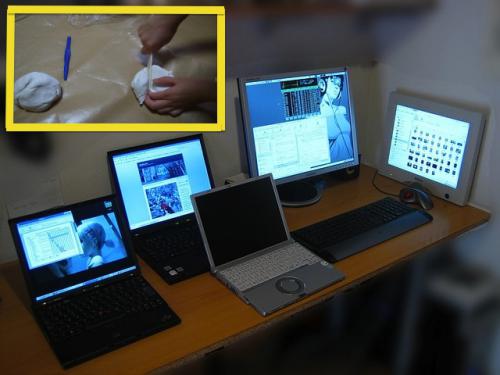
Image Credit:
Papier-mâché image: Toshiyuki IMAI
Computers image: Pablo Ruiz Múzquiz
These days I only accept student papers through electronic submission, but this May I’ll have quite a handful of things to carry away (literally) from my last class.
Let me explain.
For their final project, and as is the case in many other Rhetoric classes at UT, my students must create an argument toward the controversy they’ve been researching all semester. They can choose any medium they’d like. To offer some potential jumping off points, my prompt suggests ideas like a website, a video, an image, a political cartoon, or a song. Part of my pedagogical goal is for them to try something new, along the lines of the multimedia arguments we’ve been analyzing over the course of the semester. Whatever medium they choose, I also require that they defend this rhetorical choice in a presentation and reflection paper—so it’s not just a question of what type of project they most “feel like” doing.
Since we have access to so many great materials in our DWRL classroom, I also include whole class days dedicated to requiring students to try out iMovie, Photoshop, and easy-to-use website builders like Wix and Weebly. Many students are initially intimidated by such programs but go on to fulfill my teacherly hopes by developing confidence through these in-class exercises.
Other students, however, choose a different route.
To illustrate what I mean, at the end of last semester I received:
- eleven websites
- five videos
- two magazine spreads
- one brochure
- …and one hardcover book, handmade by a student using scrapbooking and other crafting materials.
Based on my current students’ project proposals, this semester I can anticipate receiving:
- five websites
- four videos
- five magazine spreads
- one infographic
- one song
- one political cartoon
- …and one hardcover book, one poster board, and yes, one model of Machu Picchu.
Why, in a specialized Digital Writing & Research Lab classroom, after a semester of analyzing a range of digitally produced arguments, and after several class days of working with digital multimedia tools, are some students still driven to create physical objects?
It’s certainly not a slacker move, since these students all know that creating a physical project will likely be highly labor-intensive. I warned them that the student who submitted the hardcover book last semester lamented that her project required substantially more hours of work than did many of her classmates’ projects. Despite this cautionary tale, I now have three students committed to creating a physical object. (I can’t even fathom how much time the Machu Picchu replica will take. The student told me he plans to use Styrofoam, papier-mâché, and various tools of which I’ve never heard, but which he assures me he will use in a well ventilated space.)
And what’s a digital lab instructor to do with this insistence on working with decidedly non-digital media in a digital classroom? I suppose I could require that final projects entail a digital component, but I find myself hesitant to do so. Frankly, when my colleagues ask how my class is going, I am surprised to be especially eager to mention the non-digital final projects. To be sure, I’m no less impressed by Wix-built websites or Photoshop-designed magazine spreads. Somehow, though, there’s a compelling novelty—and I use that word advisedly—in students handing over a physical object, especially when all of their previous assignments have been submitted electronically.
Clearly, there’s a role for physical objects to play in digital spaces—but how should we approach that role? I have no brilliant answers just yet, but if you catch me clumsily hauling a book, a poster, and a Machu Picchu model out of my basement classroom in a few weeks, at least you’ll know what I’ll be mulling over.

